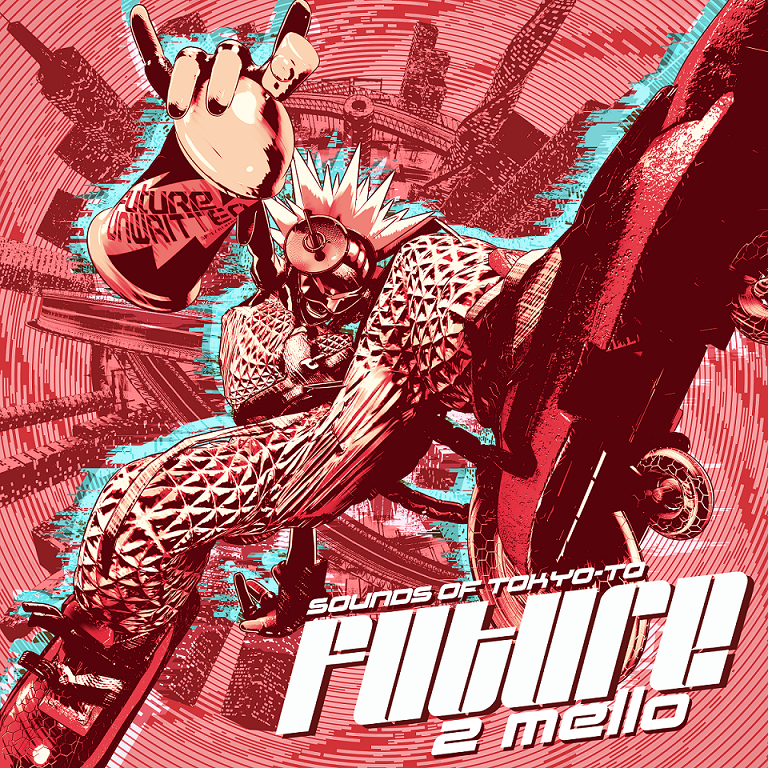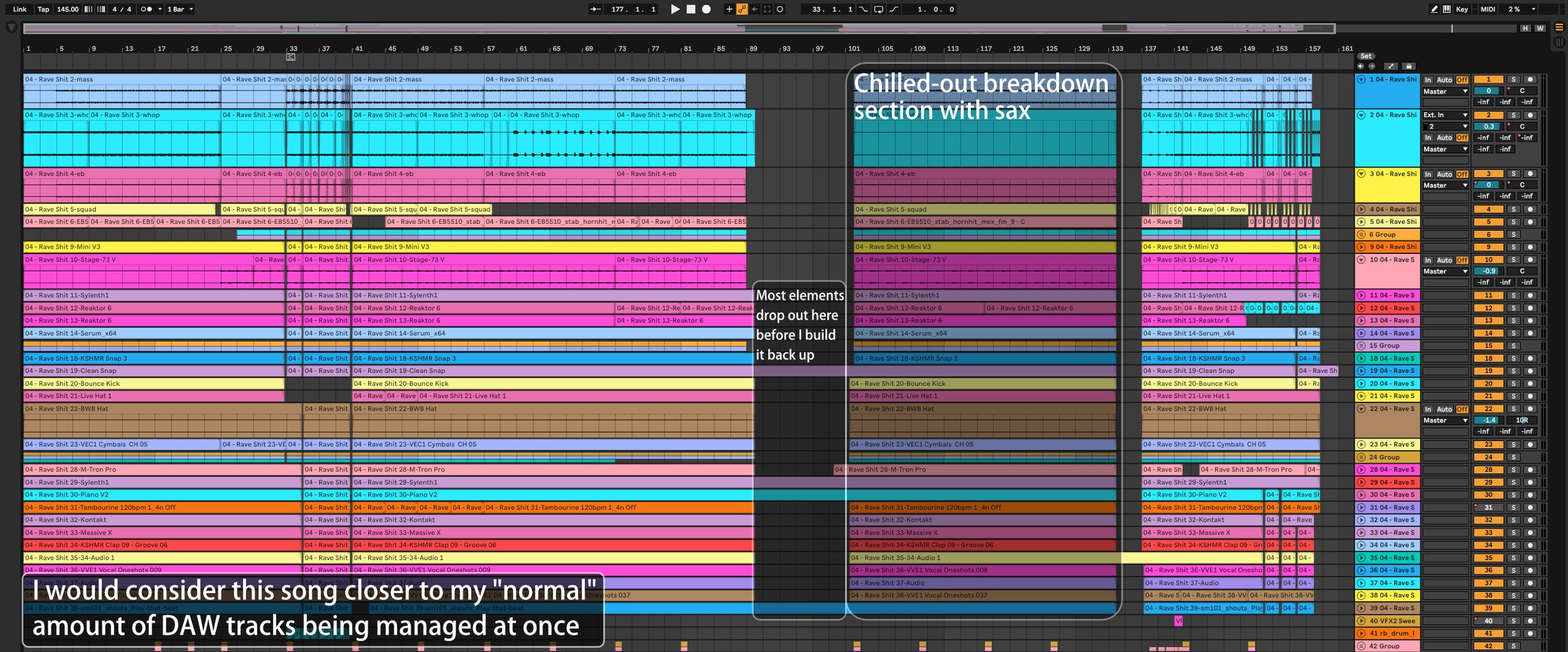CREATING SOUNDS OF TOKYO-TO FUTURE PART 3: "RAVE SHIT"
Album art by Ethan Redd
“RAVE SHIT”
Audio Track Count: 39 (a light snack!)
Favorite Sound: The lo-fi horn hit playing out the main melody (first appearance 0:11)
Cutting-Room Floor: Nothing. I think everything I made for RAVE SHIT is in RAVE SHIT.
Inspirations: Street Fighter III: 3rd Strike, The Prodigy’s “Breathe”, grungy electronica and the rave genre, low-tempo jungle
We’ve arrived at the only single from the album, the less-than-fully-monetizable title “RAVE SHIT”. The song started here, as a coffee shop sketch that had me riffing off the moody jazz and breakbeat energy of my favorite moments of Street Fighter III: 3rd Strike’s soundtrack.
“RAVE SHIT” became the debut single for the album for a simple reason: it was the only song that was even close to done when I needed to figure out my promo. However, the more I thought about it, the more I knew I would have chosen it anyway and loved that it was my option. I wanted a curve-ball to start things off with.
I love this song, but I knew it would immediately be a much different energy than the stuff on the previous album. I also don’t think it’s my best work on the new album. It’s a little slower, much more low-energy and cooled, dimly lit and full of quirky sounds… but this one’s for me, this is a sound I like. Some people might not be happy with this being their first taste after all that wait, and I thought this might lead them to underrate the project as it headed in. Then I’d create that feeling of joyous surprise as they find it has tons of the stuff they were expecting, plus more. I want everyone to have that feeling of something soaring over your lowered expectations and bringing you up with it.
My process with “RAVE SHIT” was to keep upping the ante throughout its progression in a more gradual way than some of the other productions on the album. One breakbeat, then three on top of each other, then the grungy horn hit sample and bass teasing out the melody for a while. One of my personal favorite moments on the album is when I dump you out into that deep, velvety electric piano chord progression breakdown with the horn hits playing out the full melody and that screechy break in the background. Then, I drop the breakbeats back in only to reveal (“play that!”) that wasn’t even the real drop and there’s this whole new part with different drums and synth sounds. My second favorite sound in the song is the chopped break at 1:01 with the screaming sound–that’s the break from the very intro, only pitched up. I bring it back in at its original pitch for more chops later at 1:33. That sound was incredibly versatile and allowed me to make this song as rough, rugged and scratchy as I wanted it.
That’s where the “RAVE” in the title comes from, the attitude of the principal elements of the song. They’re all less than high fidelity–the breaks, horn hit, vocal sounds are all lower quality than I’d typically prefer to work with, but I wanted this song to have a unique texture. It’s pretty scary to put out a song with parts that sound intentionally dirty or rough as the big first single of your shiny, sleek “future” album. At times I was like “what are you doing?”, but the truth is that I would want to bring sounds like this into the “future” because I still love them and think they will always have a place. Dirty samples that can’t shake the vestiges of whatever audio bushel they were plucked from, that stick out in a sparkly mix, are underrated and underutilized. I was willing to put in the time to get them to work and not feel out of place in a more punchy, clean and modern context. I wanted to create layers of samples that were confounding and mysterious in origin, even if it did confound me for a while to figure out how I was going to keep harsh sounds from out-harshing each other.
A big problem spot was 0:48 to 1:27–the harsh midrange horn hit, harsh screeching break sample and harsh crunchy drums all had to occupy the song at once with no fighting. Even the hi-hat—the most complementary, gentle click of a sound you can get—started to feel harsh! Pitching up that chopped vocal break, my second favorite sound as mentioned before, actually was the thing that made it all click. By changing this one part of my crunchy drum loop stack, I got it out of the way and onto a higher frequency to give other sounds some space. That was a real nightmare, though. I even bought a new plugin to tame certain frequencies–not an ad, but oeksound’s soothe2 is indispensable to me now. I wish I had this when I was frankensteining together mashups back in the day. The choir singing that comes in at 1:54 is another element that was really hard to fit in, but my love affair with using some slight overdrive distortion on choirs to make them pop began here.
(Using the actual song’s project file this time instead of the separate mixdown file for detail; this is the Big Problem Spot and I’ve highlighted every track that was fighting with other tracks. Imagine nudging all of these slightly in repeated drafts until they all play nice…)
I wish I could be more descriptive when talking about how the “RAVE SHIT” breakdown was made, but to tell you the truth, everything from 2:24 to 3:38 is completely from the producer flow state. My favorite place to be! One thing I can say is that I find it really, really easy and natural to restart the energy of a song if I can break it down to one really different element (the synth chirping at 2:24) and slowly build it back up again. By adding the lo-fi MIDI sax on top, I was continuing to ride on the 3rd Strike energy and those lovely CPS-3 game sampled sounds. I knew from my composition on Later Alligator that I could make MIDI horns surprisingly lively with subtle pitch bends and some distortion, and avoid making the worst sound on Earth, so I let it soar. I end out the song by bringing some of my favorite segments from the first part back in slightly new arrangements.
(My MIDI sax pitch bends, to add a little style to what can be a very cursed sound if you let it)
I realize that every one of these blog entries so far has coincidentally had some information linking the song to a bigger context: ”Break” being connected to my last trip to MAGFest before everything was locked down, “Life On The Line” being about industry experiences and taking a financial risk on the album. I just wanted to note that not every song will have a Big Album Story Connection like that as we continue. But before we can get to that–it’s time to talk about the music video for “RAVE SHIT”.
Even as I was listening to that first coffee shop draft of “RAVE SHIT”, I had this image in my head of a scene of mellow chaos brought on by work on the album. I imagined myself lying on the floor of an apartment, lit by purple and blue LEDs and surrounded by the detritus of frustrated creative activity, having the most aesthetically digestible mental breakdown possible. Even before I was inside and cooped up for a long time, I thought it should have the feeling of being inside and cooped up for a long time, because that was just my life working on this album anyway. I came up with a kind of faked time-lapse as the concept of the video, showing me stressing out from the perspective of the computer with a shot like this one from the Steins;Gate’s anime in mind.
I liked the way this lens made me the focal point and warped the room so that it seemed like it was surrounding and binding me. I thought it spiced up what was a pretty basic shot, and one I’d be holding on for over 2 minutes, so it needed all the spice it could get. As I developed the structure of the song, I finished a really basic story outline–from the intro to the end of the first section of 2:24 is a “work day”, showing me barely getting anything done in the face of several small distractions and holdups. The most important one is the fact that I’m clearly not feeling what I’m making at all, and I can’t get in the flow state. I wanted to try to get across what most creative days on a difficult project actually look like, the “chaff” days that aren’t usually depicted.
After I turn the light off and pass out (I don’t know why I physically pick the piano keyboard up and move it away from the computer, but sometimes it does feel that bad to make music) I start having a dream about the most opposite place possible. I’m deep in the woods, getting a lot of sun and warmth and engagement with nature, not having to do anything in particular but move through this peaceful space. I also got to have a salamander on my hand!
I didn’t intend for the whole staying inside/freedom in the sunshine comparison to feel like a reminder that this album was made during the beginning of the pandemic. I’m sure a lot of people assume that’s what it is, but it’s more about the way I obsess over my work without taking breaks and getting some healthy separation. I ignore what my brain is telling me it needs and giving me vivid dreams about, instead choosing to “buckle down” further and further on the task at hand. This is why the video ends with me waking up in a frantic mess and launching into another day of throwing myself at the creative block wall, instead of taking any time to reflect on the dream I had.
The dark, dimly-lit room of my apartment in the video matches well with the sound of RAVE SHIT, but not with the feeling I wanted for the album as a whole. This was something actually related to the pandemic, the fact that this bright and energetic album turned out to need to be made alone in a stuffy dark room over months as I fought for any stimuli, any spark to allow me to do something inspiring. This was an album that needed to breathe, to get essential vitamins and minerals, to experience life and travel and joy–instead I had to slowly nurse it to its full health in the worst environment possible. I had a lot of worries about the final result that turned out to be unfounded, but still, I hope I never have to make something in an environment so opposite to its energy again.
I naturally expect things I make to turn out pretty second-rate compared to the things others make (I know, I know, it’s just how I work) but the video turned out a lot better than I expected, and I’m just as proud of it as I am of the rest of the album. I hope you have all enjoyed this story of “RAVE SHIT”, video and song.
That’s all for now—I’ll be discussing track 4, “Dance With U Long” here next Tuesday, January 25!
Above: Full view of the “Rave Shit” mixdown in Ableton Live. Most DAW programs arrange music from left to right on the timeline, so the left end is my intro and the right end is my ending, with every sound placed in a linear fashion. The rows are audio tracks or grouped tracks—I called them “layers” in my description to match how listeners probably more commonly think of them.






